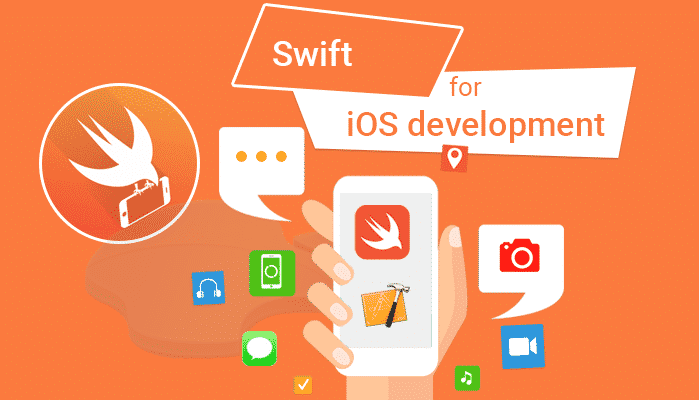Swift is an effective programming language made by Apple as a contrasting option to Objective-C. Since its official release in 2014, Swift has progressed significantly from being disputable and frequently condemned to turning into the most mainstream programming language.
Swift is essentially used to fabricate applications for iOS, Mac, Apple TV and so on the language has been immediately adopted by designers in the iOS people group. With Apple’s current “huge move” of publicly releasing its brand new programming language—Swift is expected to grow at a much larger pace.
Although Objective-C and Swift have a decent interoperability, their programming designs are extraordinary. So on the off chance that you move Objective-C code to Swift, there is a high hazard. Composing just new code in Swift is a decent trade-off. Since the operability between Objective-C and Swift is great, you can compose new code and new classes in Swift, and they can communicate with your current Objective-C code.
A large portion of the gifted designers are embracing Swift and are moving their current projects to it, which is astounding for such a young innovation. However, it appears its forerunner won’t lose its balance at any point in the near future. So how about we observe why we should move to quick for iOS improvement:
1. An easy to read language
The Objective-C language presented new keywords utilizing @ symbol. As Swift did not depend on C language, it can bring together every one of the numerous @ symbol before each Objective-C compose. In Swift, you needn’t bother with semicolons toward the finish of each line of code and no parenthesis to surround if/else conditional statements. The impact is a cleaner language with a simple sentence structure and syntax. Swift code all the more nearly looks like common English. The comprehensibility makes it less demanding for existing developers from JavaScript, Java, Python, C#, and C++ to receive Swift into their code.
2. It is built with safety in mind
Swift was designed by keeping in mind the safety of the code hence it never allows you to write bad code by generating compiler error whenever you try to do so. It creates a short feedback loop and allows to code with intention. You can fix the problems while writing the code, which helps to reduce the cost of fixing bugs at the end. This result in fewer crashes and bugs in production, which significantly reduces the amount of time and money spent during the testing phases of development of any application.
3. Swift apps are faster
Apple has positioned Swift as a fast and lightweight language (as its name speaks). Apple published official information saying that Swift is about 2.6 times faster than Objective-C. With Swift adopting a static system, one can expect that Swift should be at least as fast as or faster than Objective-C. An example can be seen in form of comparison of sorting time of swift with Objective-C shown below.

4. Less coding
Swift reduces heavily the lines of code required for iterative statements and managing strings. It has features like adding two strings with a ‘plus’ operator, which is missing in Objective-C. The different types in Swift reduce the difficulty of code, as the compiler can figure out types.
5. Easy to maintain
Less code means less legacy and reduced cost of maintenance. Being a compact language, Swift requires less code to play out indistinguishable errands from Objective-C. Swift combines the Objective-C header and execution records into a solitary code document. For instance, Lyft has recently re-designed its portable application utilizing Swift. The company could reduce the code base by more than 70%, from 75,000 to 22,000 lines of code, while keeping the same functionality and performance.
6. Support for dynamic libraries
The major change in Swift is switching from static libraries to dynamic libraries. Dynamic libraries are executable code which allows current Swift apps to link with the latest versions of the Swift language. Earlier iOS did not support the dynamic library features but with the launch of Swift, they are included in the downloaded app although being external. They basically reduce the initial size of an app when loaded into memory.
7. Memory management
Swift language prevents the huge memory leaks that a programmer can have in Objective-C. It has an automatic reference counting provided across all paths. So there is no need for a programmer to think about memory for every digital object.
8. Strong corporate support
Not only Apple but IBM is also working on the Swift development and research projects actively.IBM has taken the initiative to bring this technology to the cloud platform and look towards the server side aspect of it. So choosing Swift for your project will help you grow further in terms of technology and you will have the necessary support.
9. Rich open source ecosystem
Swift has an open source status so it is open to inviting the development from various developers and has a rich stock of libraries, frameworks, and tools. Being an open source project it is feasible both in terms of time and speed. Swift is growing beyond Apple ecosystem and expanding to Android environment as well. So soon we will be able to use it for the application development of android operating system and also for the backend systems.
Overall, with the boom in Mobile Apps and more demand for iOS developers, those who already know Objective C well should learn Swift as it’s the need of the hour. They can start writing new code in Swift and as it gains more popularity, stability and security can fully shift to Swift. It is difficult to ask developers to shift from an easy to difficult language, but the case is exactly reverse her and should be an easy transition for the developers since Swift is more developer friendly and natural as compared to Objective C.



